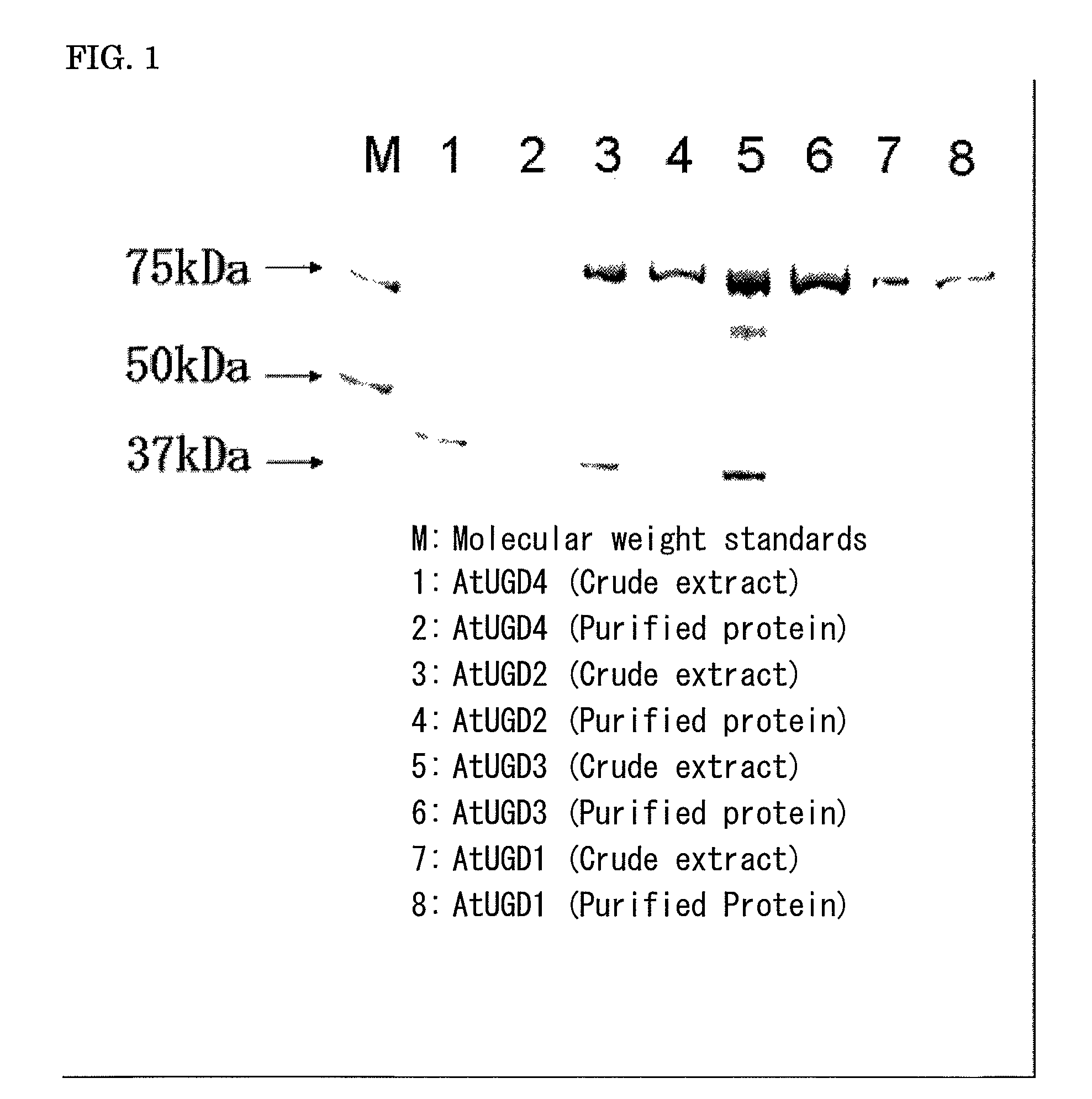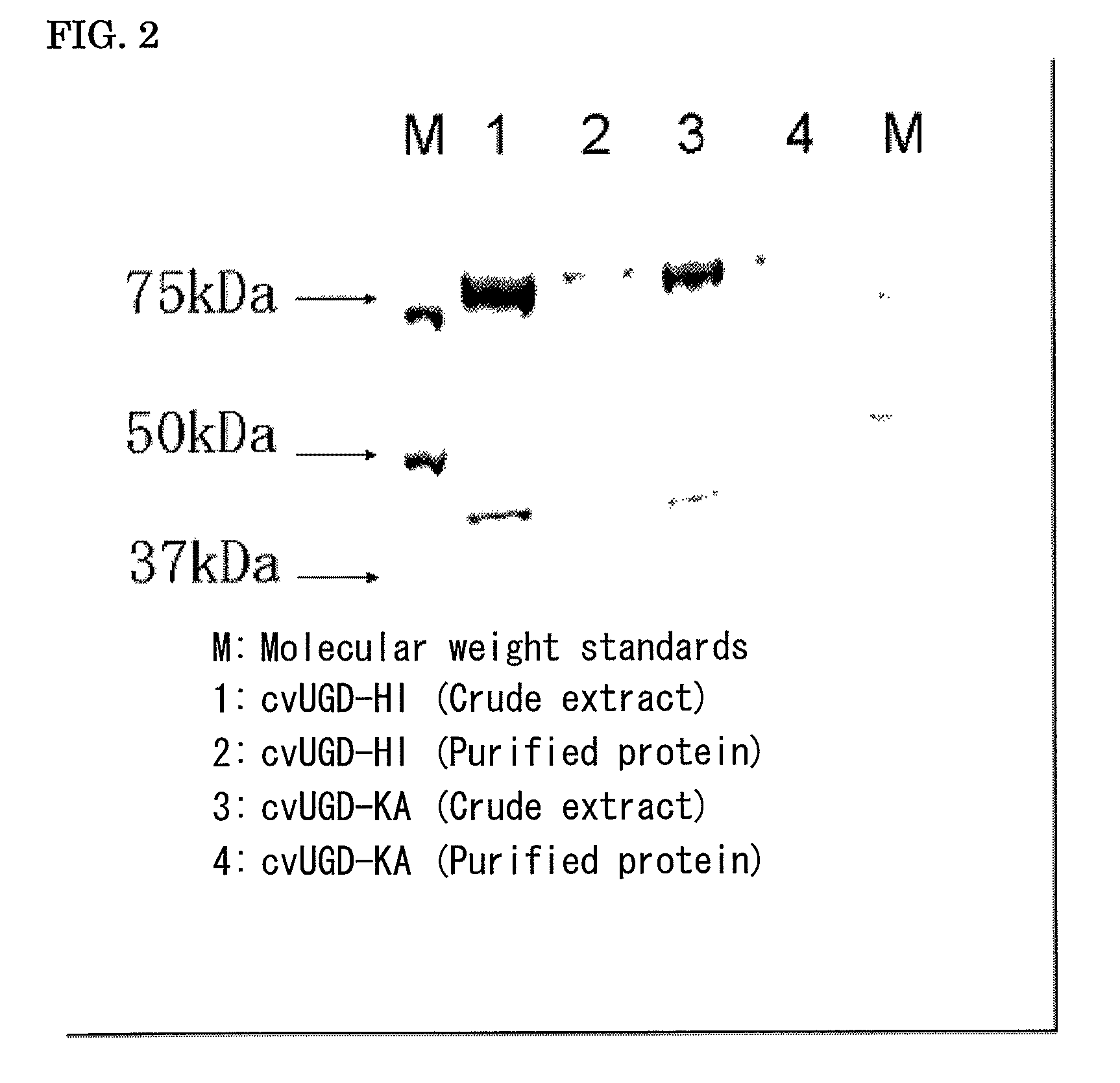Plant producing hyaluronic acid
a technology of hyaluronic acid and plants, applied in the field of plants producing hyaluronic acid, can solve the problems of microbial fermentation, high cost, high cost of production, etc., and achieve the effect of high production in plants and low cos
- Summary
- Abstract
- Description
- Claims
- Application Information
AI Technical Summary
Benefits of technology
Problems solved by technology
Method used
Image
Examples
example 7
Subcloning of Chlorella-Virus-Derived GFAT Gene and HAS Gene into pBluescript
[0244]pBIHA was digested with the restriction enzymes PvuII and PstI, in that order, and subcloned into the PstI and SmaI sites of pBluescript to obtain pBluescript / 35S-cvHAS-NOS (hereinafter sometimes referred to as pBSHA).
[0245]pBIGF was digested with the restriction enzymes PvuII and SphI, in that order. After blunting with Blunting High (Toyobo), pBIGF was subcloned into the EcoRV site of pBluescript to obtain pBluescript / 35S-cvGFAT-NOS (hereinafter sometimes referred to as pBSGF).
[0246]pBSGF was digested with the restriction enzymes KpnI and NotI, in that order. After blunting with Blunting High (Toyobo), 35S-cvGFAT-NOS was subcloned into pBSHA previously digested with SpeI, blunting, and dephosphorylation, in that order, to obtain pBluescript / cvHAS-cvGFAT (hereinafter sometimes referred to as pBSHG).
example 8
Cloning of Chlorella-Virus-Derived GFAT Gene and HAS Gene into pBI121
[0247]pBSHG was digested with the restriction enzymes KpnI and NotI in that order, and the expression cassette of cvHAS-cvGFAT was cleaved and blunted. Then, cvHAS-cvGFAT was inserted into the expression vector pBI121 as follows: pBI121 was digested with the restriction enzymes SacI and HindIII, and blunted with Blunting High, and then the cvHAS-cvGFAT gene digested with the above restriction enzymes was cloned. Using the ligation mixture, Escherichia coli strain DH5α was transformed according to the above-mentioned known method, and the transformants were applied to LB agar medium containing 50 μg / mL ampicillin, and cultured overnight at 37° C. The plasmid was extracted from the grown colonies of the transformants using a known method. Thus, pBI121 / cvHAS-cvGFAT (hereinafter sometimes referred to as pBIHG) containing cvHAS-cvGFAT was prepared.
example 9
Preparation of Electrocompetent Cells
[0248]Five milliliters of LB medium was inoculated with a single colony of Agrobacterium LBA4404 (Agrobacterium tumefaciens strain LBA4404), and subjected to shaking culture overnight at 28° C. The culture medium was inoculated into 500 mL of LB medium and subjected to shaking culture at 28° C. until the turbidity at 600 nm became 0.5. The culture medium was harvested by centrifugation (5000 rpm, 10 min, 4° C.); the supernatant was removed; 500 mL of sterile water was added to suspend and wash the cells; centrifugation (5000 rpm, 10 min, 4° C.) was carried out again to harvest the cells; and the supernatant was removed. After performing the above procedure twice, the precipitates were suspended in 20 mL of cooled 10% glycerol solution, the cells were harvested by centrifugation (5000 rpm, 10 min, 4° C.), and the supernatant was removed. The precipitates were suspended in 3 mL of cooled 10% glycerol solution, and 40-μL aliquots of the suspension w...
PUM
| Property | Measurement | Unit |
|---|---|---|
| pH | aaaaa | aaaaa |
| temperature | aaaaa | aaaaa |
| pH | aaaaa | aaaaa |
Abstract
Description
Claims
Application Information
 Login to View More
Login to View More - R&D
- Intellectual Property
- Life Sciences
- Materials
- Tech Scout
- Unparalleled Data Quality
- Higher Quality Content
- 60% Fewer Hallucinations
Browse by: Latest US Patents, China's latest patents, Technical Efficacy Thesaurus, Application Domain, Technology Topic, Popular Technical Reports.
© 2025 PatSnap. All rights reserved.Legal|Privacy policy|Modern Slavery Act Transparency Statement|Sitemap|About US| Contact US: help@patsnap.com



